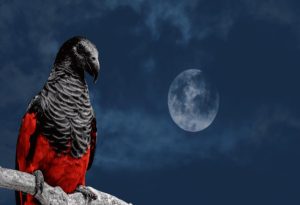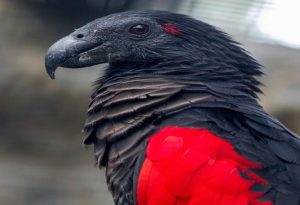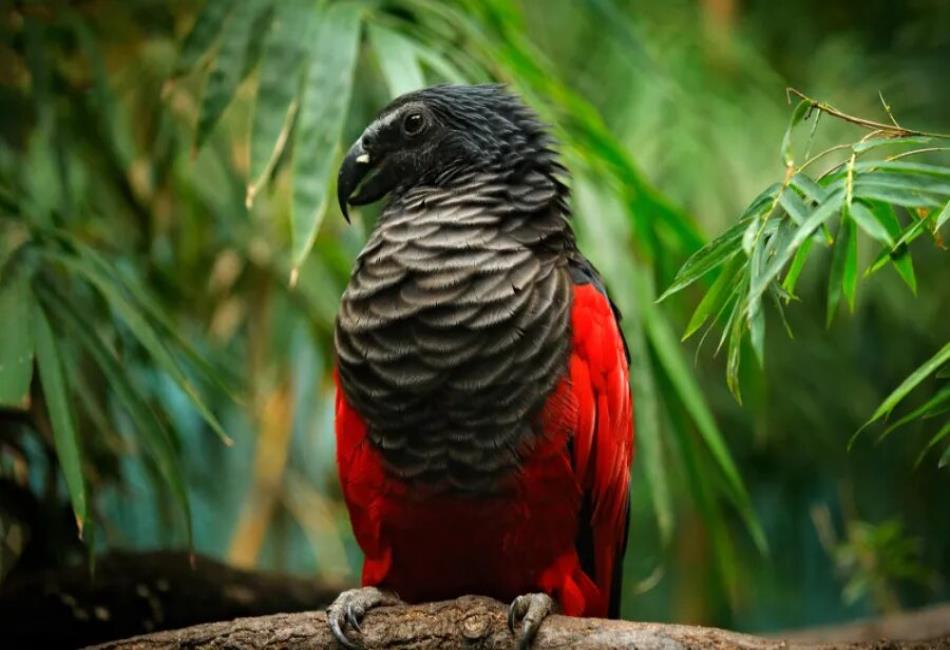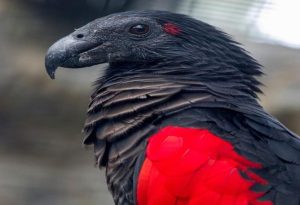The Vampire Parrot: Nature’s Blood-Drinking Enigma of the Avian World
Introduction
In the rich biodiversity of New Guinea’s remote rainforests, a striking and bizarre bird quietly carves out its place in avian lore: the vampire parrot, formally known as the Vulturine Parrot (Pyrrhura vulturina). Despite its rather chilling nickname, this parrot is not a fictional creature from a gothic novel but a real, living species with unusual dietary habits that have stunned ornithologists. Unlike its fruit-eating and nut-cracking cousins, the vampire parrot has a taste for blood — a behavior that is both rare and fascinating in the world of birds.
This article explores the biology, habitat, feeding behavior, and the mystery surrounding this peculiar parrot, while also addressing conservation concerns and cultural intrigue.

1. Meet the Vampire Parrot: An Overview
The vampire parrot is not a separate species created for shock value, but a common name for a particular behavior observed in the Vulturine Parrot or Pesquet’s Parrot (Psittrichas fulgidus). This bird is native to the hill and montane rainforests of New Guinea, where it blends among lush foliage with its dark plumage and vulture-like appearance.
Named for its bare, vulture-esque head, the parrot is strikingly unique among its family. Its bald head — a rare trait in parrots — is thought to be an evolutionary adaptation to avoid getting sticky pulp or blood on its feathers during feeding.
While most of its diet consists of fruits, particularly figs, there have been rare but documented observations of these parrots feeding on open sores or wounds on other birds, hence the vampiric reputation.
2. Anatomy and Appearance
Pesquet’s Parrot stands out in more ways than one:
-
Size: Approximately 46 cm (18 in) long and weighing around 700–800 grams.
-
Coloration: Primarily black with vivid red plumage on the belly and wings, creating a striking contrast.
-
Beak: Curved and powerful, suited for tearing into fruit or soft flesh.
-
Head: Featherless and dark, enhancing its eerie resemblance to a vulture.
Its physical characteristics support a mostly frugivorous lifestyle, but the lack of feathers on its head hints at messier feeding behaviors as well.
3. Vampiric Feeding Behavior: Fact or Fiction?
Despite the horror-movie moniker, the vampire parrot does not exclusively drink blood like a bat. The term refers to a rare behavior noted by some scientists and bird watchers: these parrots have occasionally been seen pecking at and consuming small amounts of blood from open wounds on other birds — typically seabirds or injured animals.
This scavenger-like behavior is likely opportunistic rather than habitual, similar to how some herbivores may nibble on meat when desperate for nutrients. Still, it’s highly unusual for a parrot, hence the fascination.
4. Ecological Role and Habitat
The vampire parrot is endemic to New Guinea, primarily in the lowland and montane forests between elevations of 600–1200 meters. Its habitat is rich in fruit trees, particularly figs, which form the bulk of its diet.
Ecologically, it plays a role in seed dispersal — like most frugivores — which contributes to forest regeneration. By consuming fruits and excreting seeds elsewhere, it helps maintain the forest’s health and biodiversity.
5. Conservation Status and Threats
Unfortunately, Pesquet’s Parrot is currently listed as Vulnerable on the IUCN Red List.
Threats include:
-
Habitat loss due to deforestation for agriculture and logging.
-
Hunting for its beautiful red and black feathers, which are used in traditional ceremonial attire.
-
Illegal wildlife trade, where exotic birds are trafficked for their unique appearance.
Efforts are underway by conservation organizations to educate locals, enforce anti-poaching laws, and promote sustainable tourism as a way to protect this unique species.
6. Cultural Significance and Symbolism
In some indigenous cultures of New Guinea, the vampire parrot is revered and feared for its unusual appearance and habits. Its feathers are sometimes used in headdresses and ceremonial outfits, signifying power or mystery.
Due to its bold appearance and strange behaviors, the bird has also found a place in mythology and folklore, sometimes associated with forest spirits or omens.
7. Why It Fascinates Scientists and Bird Lovers
The vampire parrot captures attention not just for its looks or behavior but for the way it challenges our understanding of parrots. Typically seen as colorful, social, and gentle fruit-eaters, the idea that one might exhibit vampiric tendencies opens doors to new evolutionary questions.
-
Why did it evolve a bald head?
-
Is blood consumption a learned or instinctual behavior?
-
Could climate change or habitat loss influence its dietary shifts?
These questions continue to fuel research and curiosity in the scientific community.
8. Fun Facts About the Vampire Parrot
-
It is one of the only parrots with a bare head, much like vultures.
-
Unlike most parrots, Pesquet’s Parrot is not a great talker and does not mimic sounds.
-
It has a short lifespan in captivity due to its specialized diet and sensitivity to stress.
-
Despite its ominous name, it is non-aggressive toward humans and other birds when undisturbed.
Conclusion
The vampire parrot — a moniker that blends science with sensationalism — is a bird that defies expectations. With its unusual appearance, rare blood-drinking behavior, and vulnerable status, Pesquet’s Parrot represents the mysteries of evolution and the delicate balance of rainforest ecosystems.
Whether you see it as nature’s oddity or a misunderstood marvel, one thing is clear: the vampire parrot is a reminder of how little we truly know about the wild creatures sharing our planet — and how important it is to protect them.
FAQs: The Vampire Parrot – Nature’s Blood-Drinking Enigma of the Avian World
Q1: What is the vampire parrot?
A: The vampire parrot is a nickname for Pesquet’s Parrot (also known as the Vulturine Parrot), a rare bird native to New Guinea known for its bald, vulture-like head and unusual feeding habits.
Q2: Does the vampire parrot actually drink blood?
A: While not a regular blood-drinker, it has been observed occasionally feeding on open wounds of other birds, leading to its vampiric reputation.
Q3: Why does it have a bald head?
A: Its featherless head helps prevent mess from sticky fruit pulp or blood, which could otherwise mat feathers and lead to hygiene issues.
Q4: What does the vampire parrot primarily eat?
A: Its main diet consists of figs and other soft fruits, making it primarily frugivorous despite its rare scavenger-like behavior.
Q5: Where can you find the vampire parrot?
A: It is found in the hill and montane rainforests of New Guinea, usually between elevations of 600–1200 meters.
Q6: Is the vampire parrot endangered?
A: It is listed as Vulnerable due to habitat destruction, illegal trade, and hunting for its feathers.
Q7: Can vampire parrots be kept as pets?
A: No, they are highly specialized, difficult to care for, and are protected by conservation laws due to their declining population.
Q8: Why is it called a “vampire” parrot?
A: The name stems from rare sightings of the bird pecking at the wounds of other birds, combined with its vulture-like appearance.
Q9: What makes the vampire parrot unique among parrots?
A: Its bald head, large size, dark plumage with red highlights, and rare blood-feeding behavior make it one of the most unusual parrots in the world.






![Red-Breasted Toucan: [Ramphastos dicolorus] A Symphony of Colors](https://birdzpedia.com/wp-content/uploads/2024/01/Red-breasted-Toucan-768x402.png)


![Great Hornbill [Buceros bicornis]: Discovering its World](https://birdzpedia.com/wp-content/uploads/2023/12/Great-Hornbill-768x402.png)